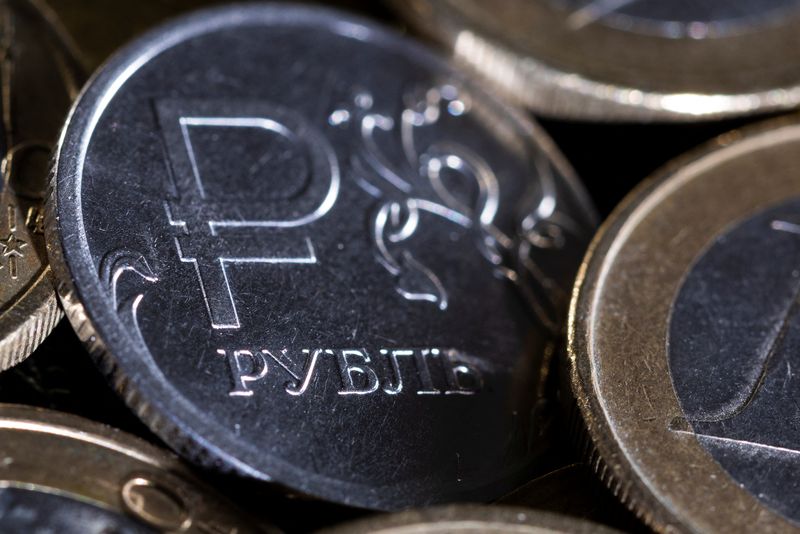Analysis-Russia’s rouble rebound not quite what it seems By Reuters

© Reuters. FILE PHOTO: Russian rouble coin is seen in this illustration taken April 7, 2022. REUTERS/Dado Ruvic/Illustration
(Reuters) – Six weeks after Russia sent troops into Ukraine, the rouble has staged an apparently extraordinary recovery, but all is not what it seems and the exchange rate used in everyday transactions is sometimes very different to the official one.
The rouble’s swift rebound on the Moscow Exchange to levels seen before Feb. 24 is being touted in state media and by some government officials as evidence that authorities have got a firm grip on the country’s finances despite being battered by the toughest Western sanctions ever.
“Our economy appears to be resilient to Western sanctions, the rouble is firming visibly,” a state TV presenter said on Friday.
The rouble rallied past 72 to the dollar on Friday, its strongest level so far this year, heading away from a record low of 121.52 it hit on March 10. Analysts polled by Reuters in late March expected the rouble to trade at 97.50 to the greenback in 12 months’ time.
For a related graphic on rebounds after hitting all-time lows, click https://tmsnrt.rs/3rdBnmV
But anyone who tries to buy foreign currency online at a bank or, illegally, at a foreign exchange booth, or who buys goods and services online denominated in foreign currencies will find the actual rate considerably worse.
And the rouble’s buying power has been sharply eroded as companies hike prices for goods, especially ones produced outside Russia whose future supply is in doubt due to the sanctions.
“I used to buy cans of Dutch-made baby formula for 2,500 roubles before Feb. 24,” said Marina, a Moscow resident, with her newborn baby. “Now the same can costs 4,500 roubles while boxes of kasha (a porridge-based drink for children) have gone up to 100 from 64 roubles for a 500-ml box.”
Since Feb. 24, food prices have soared, taking the year-to-date increase in prices for cabbage and carrots to 85% and 54%, respectively, according to statistics service Rosstat.
Prices of imported goods jumped even higher, with prices for some foreign-made cars more than doubling.
High inflation has been the key concern among households for years as it dents living standards, a fall which will be aggravated by the deepest economic contraction since 2009, a Reuters poll suggests.
A survey by state polling agency VTsIOM from February showed that 64% of people in Russia had no savings.
Emergency capital controls helped the rouble rebound in Moscow where trading volumes dwindled compared to before the Kremlin started what it calls its “special military operation” in Ukraine.
Nobel-prize winning economist Paul Krugman has said the rouble has become a crucial target for Russia to defend, “not so much because it’s all important but because it’s so clearly visible”.
“So defending the rouble, never mind the real economy, makes sense as a propaganda strategy,” Krugman said in an op-ed in the New York Times early this month.
Kremlin…
Read More: Analysis-Russia’s rouble rebound not quite what it seems By Reuters
